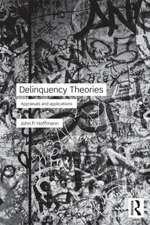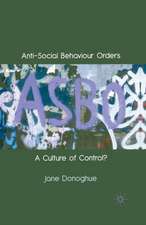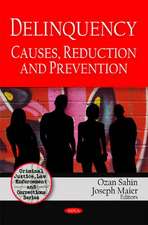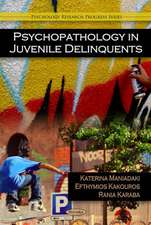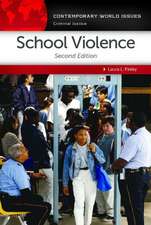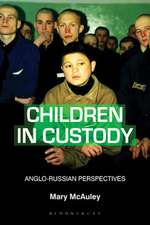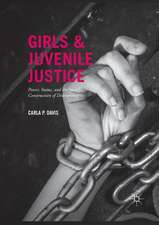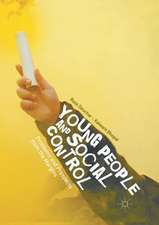Schools and the Problem of Crime
Autor Stephen Boxforden Limba Engleză Paperback – 25 iun 2015
| Toate formatele și edițiile | Preț | Express |
|---|---|---|
| Paperback (1) | 414.32 lei 6-8 săpt. | |
| Taylor & Francis – 25 iun 2015 | 414.32 lei 6-8 săpt. | |
| Hardback (1) | 950.26 lei 6-8 săpt. | |
| Taylor & Francis – iul 2006 | 950.26 lei 6-8 săpt. |
Preț: 414.32 lei
Nou
Puncte Express: 621
Preț estimativ în valută:
79.31€ • 86.17$ • 66.66£
79.31€ • 86.17$ • 66.66£
Carte tipărită la comandă
Livrare economică 21 aprilie-05 mai
Preluare comenzi: 021 569.72.76
Specificații
ISBN-13: 9781138861497
ISBN-10: 1138861499
Pagini: 288
Dimensiuni: 156 x 234 x 15 mm
Greutate: 0.41 kg
Ediția:1
Editura: Taylor & Francis
Colecția Willan
Locul publicării:Oxford, United Kingdom
ISBN-10: 1138861499
Pagini: 288
Dimensiuni: 156 x 234 x 15 mm
Greutate: 0.41 kg
Ediția:1
Editura: Taylor & Francis
Colecția Willan
Locul publicării:Oxford, United Kingdom
Cuprins
Contents Introduction 1 The Cardiff school study 2 The Cardiff school study: research design and methods 3 Offending in schools: key issues 4 Offending in Cardiff’s schools: individual and between-school differences 5 Neighbourhood context 6 Family social position 7 The school context 8 Individual characteristics 9 Lifestyle 10 Between-school differences 11 Key findings and implications References Index
Recenzii
The book under review, Schools and the Problem of Crime, is a resource about juvenile crime and violence in Britain’s schools. Due to the lack of research and literature on school crime and violence in the United Kingdom (UK) in general, this book contributes pertinent information regarding the “problems†themselves and how to initiate the investigations of these problems in schools. Overall, the book provides an overview of the types of crimes committed on school grounds, the various issues presented at each level, related explanatory factors, and implications to establish a systematic process that allows for research of crime and violence in schools. This book is useful for both researchers and practitioners (graduate degreed professionals) alike. Chapters 1 and 2 establish the importance of studying school-related crime and its contribution to the literature. Self-report studies are identified, and research design and methods are discussed to study crime in the Cardiff School. The discussion on gaining entry into the school system can be particularly important to other schools and researchers as this can be one of the biggest barriers to obtaining self-report school data. Chapters 3 and 4 provides a discussion of crime in the United States’ schools that relates the different types of studies conducted with school samples at various levels. Several of the identified studies provide both school and community contextual factors, which also include varied theoretical perspectives relative to adolescent populations in the U.S., U.K., and Canada. This chapter also incorporates other continental European studies with relevant findings to schools in the US and Canada. Conclusive of a wide array of research covered in this chapter, between-school and between-individual comparisons yield new approaches and methodology for examining school-related crime; integrated analytical approaches have implications for greater understanding of the issues that generate school crime and general delinquency. Chapters 5, 6, and 7 identify and evaluate the roles of community (neighborhood), family, and school on adolescent behavior. Each chapter provides analyses on the variables that perpetuate delinquency, and likewise, that can deter it. These chapters can be particularly useful to school districts serious about addressing crime in their schools. The outcomes presented in these chapters can be adopted and reformulated into goals and objectives tangible to school administrators and teachers in order to not only maximize learning, but to also dissuade behavioral issues that negatively impact the school environment. Chapter 8 refers to individual explanations of adolescent delinquency. Specifically, social bonding and parental monitoring are identified as concepts for analysis. Outcomes of pro-social values and self-control are shown to be significant variables that can reduce school-related delinquency. Parental monitoring and positive attitudes towards the school climate also have implications to reduce school crime. Chapter 9 discusses concepts related to student lifestyles and how these lifestyles affect individuals’ behaviors. This chapter identifies delinquent peer groups and substance abuse as key predictors of adolescent offending patterns. They are less likely to spend time at home; thereby, they are less likely to be properly monitored. These findings are consistent with previous data in current literature. Chapter 10 outlines school context and how students relate to each other. More research is needed to sort out how these contextual factors affect students and the school climate; however, the chapter reinforces the importance of school contexts in future studies. Chapter 11 concludes with the key findings and implications and brings together the point that schools are very influential to the outcomes of student crime and delinquency, and that schools should take an active part in the prevention and intervention of school crime. Moreover, the collaboration between school officials and researchers can help to bridge the gap between research and practice, and help to make schools more effective in facilitating the learning environments in which they are ultimately designed. CARRIE M. BUTLER Sam Houston State University
Descriere
What causes young people to offend? What influence do schools have on young peoples' offending behaviour in relation to other possible causal factors? These critical criminological and educational questions are addressed in Schools and the Problem of Crime.



